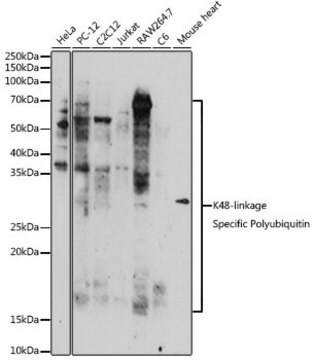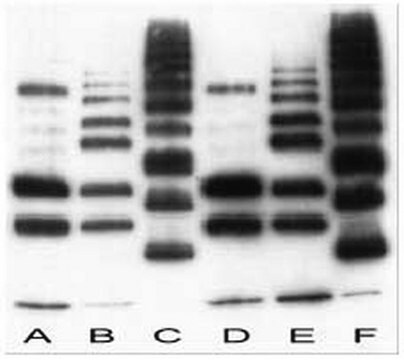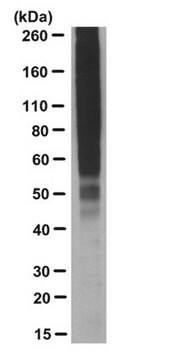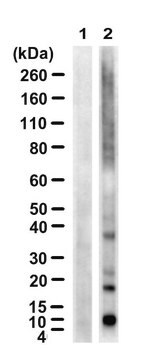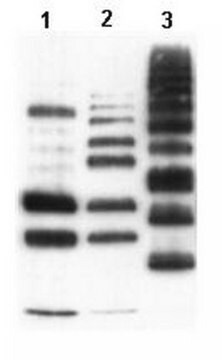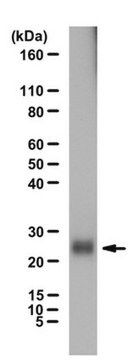05-1307
Anti-Ubiquitin Antibody, Lys48-Specific, clone Apu2, rabbit monoclonal
clone Apu2, from rabbit
Sinónimos:
Anti-HEL-S-50
About This Item
Productos recomendados
biological source
rabbit
antibody form
purified antibody
antibody product type
primary antibodies
clone
Apu2, monoclonal
species reactivity
rabbit, mouse, human, rat
technique(s)
cell based assay: suitable
flow cytometry: suitable
immunocytochemistry: suitable
immunohistochemistry: suitable
immunoprecipitation (IP): suitable
western blot: suitable
isotype
IgG
UniProt accession no.
shipped in
wet ice
target post-translational modification
unmodified
Gene Information
human ... UBAP2(55833)
General description
Di-Ubiquitin (Lys48-linked) Recombinant Protein (17-10408)
In contrast, polyubiquitin chains linked through the Lys63 residue of ubiquitin (Ub) are associated with nonproteolytic functions such as signal transduction. Lys63-linked polyUb chains connect components of NFκB signaling in a highly regulated manner, and genetic evidence indicates the involvement of Lys63-linked Ub chains in stress response and DNA repair. Research in yeast has suggested Lys63-linked Ub chains stimulate endocytosis.
Specificity
Immunogen
Application
Ubiquitin (Lys 48-specific) staining of rat brain sections (left figure) or human breast carcinoma (right figure). Staining pattern detects axons of neurons in brain tissue but not surrounding glial cells, and breast tumor cell cytoplasm is strongly detected without nuclear involvement.
Immunocytochemistry:
Confocal IF analysis of NIH/3T3, HeLa, and A431 cells using anti-Ubiquitin (Lys48 specific) (Red). Actin filaments were labeled with AlexaFluor 488-Phalloidin (Green). Nuclear material is stained with DAPI (Blue).
Flow cytometry:
Flow cytometry analysis of Jurkat cells using Anti-ubiquitin Lys48-specific (#05-1307) (blue) and rabbit IgG control (red).
Immunoprecipitation:
Rabbit monoclonal anti-ubiquitin (Lys-48-specific), clone Apu2, precipitated ubiquitin-containing proteins from HeLa cell lysates.
Inhibition Assay:
Preincubation of anti-ubiquitin, Lys48-specific, with K48-multiubiquitin chains inhibited binding to HeLa cell lysate in Western blots.
Signaling
Ubiquitin & Ubiquitin Metabolism
Quality
A 1:1000-1:5000 dilution of this lot detected Lys-48 ubiquitin chains by Western blotting.
Target description
Physical form
Storage and Stability
For maximum recovery of product, centrifuge the vial prior to removing the cap.
Analysis Note
Lys48 polyubiquitin chains.
Disclaimer
¿No encuentra el producto adecuado?
Pruebe nuestro Herramienta de selección de productos.
Optional
Storage Class
12 - Non Combustible Liquids
wgk_germany
WGK 1
flash_point_f
Not applicable
flash_point_c
Not applicable
Certificados de análisis (COA)
Busque Certificados de análisis (COA) introduciendo el número de lote del producto. Los números de lote se encuentran en la etiqueta del producto después de las palabras «Lot» o «Batch»
¿Ya tiene este producto?
Encuentre la documentación para los productos que ha comprado recientemente en la Biblioteca de documentos.
Nuestro equipo de científicos tiene experiencia en todas las áreas de investigación: Ciencias de la vida, Ciencia de los materiales, Síntesis química, Cromatografía, Analítica y muchas otras.
Póngase en contacto con el Servicio técnico


